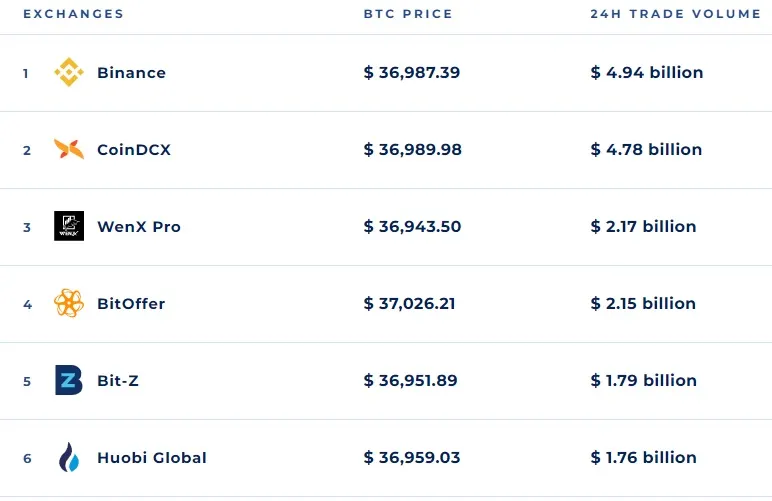In brief
- Crypto arbitrage takes advantage of the fact that cryptocurrencies can be priced differently on different exchanges.
- Arbitrageurs can trade between exchanges or perform triangular arbitrage on a single exchange.
- Risks associated with arbitrage trading include slippage, price movement and transfer fees.
Every day, tens of billions of dollars worth of cryptocurrency changes hands in millions of trades. But unlike traditional stock exchanges, there are dozens of cryptocurrency exchanges, each displaying different prices for the same cryptocurrencies.
For savvy traders—and ones who aren’t averse to a little risk—that opens up an opportunity to get the edge over their compatriots: play these exchanges against each other. Welcome to the world of crypto arbitrage.
What is crypto arbitrage?
Arbitrage is a trading strategy in which an asset is purchased in one market and sold immediately in another market at a higher price, exploiting the price difference to turn a profit.
Crypto arbitrage is fairly self-explanatory; it's arbitrage using crypto as the asset in question. This strategy takes advantage of how cryptocurrencies are priced differently on different exchanges. On Coinbase, Bitcoin might be priced at $10,000, while on Binance it could be priced at $9,800. Exploiting this difference in price is the key to arbitrage. A trader could buy Bitcoin on Binance, transfer it to Coinbase, and sell the Bitcoin—profiting by around $200.
Speed is the name of the game—these gaps usually don’t last very long. But the profits can be immense if the arbitrageur times the market correctly. When Filecoin hit exchanges in October 2020, some exchanges listed the price for $30 in the first few hours. Others? $200.
How do crypto prices work?
So how does cryptocurrency get its value? Some critics point out that cryptocurrency is not backed by anything, so any value assigned to it is purely speculative. The counterargument is roughly that if people are willing to pay for a cryptocurrency, then that coin has value. Like most unresolved arguments, there’s truth to both sides.
On exchanges, the game plays out in order books. These order books contain buy and sell orders at different prices. For example, a trader could make a “buy” order to buy one Bitcoin for $30,000. This order would go on the order book. If another trader wants to sell one Bitcoin for $30,000, they could add a “sell” order to the book, thus fulfilling the trade. The buy order is then taken off the order book as it has been filled. This process is called a trade.
Cryptocurrency exchanges price a cryptocurrency on the most recent trade. This could come from a buy order or a sell order. Taking the original example, if the sale of the lone Bitcoin for $30,000 was the most recently completed trade, the exchange would set the price at $30,000. A trader who then sells two Bitcoin for $30,100 would move the price to $30,100, and so on. The quantity of crypto traded doesn’t matter, all that matters is the most recent price.
Each crypto exchange prices cryptocurrencies this way, save for some crypto exchanges that base their prices on other cryptocurrency exchanges.
Different types of arbitrage
Between exchanges
One method of crypto arbitrage is to buy a cryptocurrency on one exchange, then transfer it to another exchange where the currency is sold at a higher price. There are a few problems with this method, however. Spreads usually only exist for a matter of seconds, but transferring between exchanges can take minutes. Transfer fees are another issue, as moving crypto from one exchange to another incurs a charge, whether through withdrawal, deposit or network fees.

One way that arbitrageurs get around transaction fees is to hold currency on two different exchanges. A trader employing this method can then buy and sell a cryptocurrency simultaneously.
Here’s how that might play out: A trader might have $30,000 in a US dollar-pegged stablecoin on Binance and one Bitcoin on Coinbase. When Bitcoin is valued at $30,200 on Coinbase but only $30,000 on Binance, the trader would buy the Bitcoin (using the stablecoin) on Binance and sell the Bitcoin on Coinbase. They would neither gain nor lose a Bitcoin, but they would be making $200 due to the spread between the two exchanges.
Did you know?
USDT (Tether) is a cryptocurrency tied to the price of one US Dollar. Cryptocurrency traders often use it because of its relative stability. It makes it easier to hold cryptocurrencies without the risk that its price will massively decrease. The advantage to holding stablecoins such as Tether, instead of converting crypto to cash is that crypto-to-fiat transfers often incur huge charges.
Triangular arbitrage
This method involves taking three different cryptocurrencies and trading the difference between them on one exchange. (Since it all takes place on one exchange, transfer fees aren’t an issue).
So, a trader might see an opportunity in arbitrage involving Bitcoin, Ethereum and XRP. One or more of these cryptocurrencies may be undervalued on the exchange. So a trader might take advantage of arbitrage opportunities by selling their Bitcoin for Ethereum, then using that Ethereum to buy XRP, before finishing by buying Bitcoin back with the XRP. If their strategy made sense, then the trader will have more Bitcoin at the end than when they started.
Statistical Arbitrage
Statistical arbitrage involves using quantitative data models to trade crypto. A statistical arbitration bot might trade hundreds of different cryptocurrencies at once, carefully working out the chance that a bot might profit from a trade based on a mathematical model, and going "long" or "short" on a trade.
Generally, a bot will give a cryptocurrency that's performed really well a low score and once that's performed particularly badly a high score; there are bigger profits to be reaped from those that performed well. A trading algorithm worth its salt will be great at creating mathematical models that can predict the price of cryptocurrencies and can expertly trade them against each other.
Decentralized Finance (DeFi) Arbitrage
Decentralized finance, or DeFi, refers to non-custodial financial protocols that operate, without human intervention, as lending protocols, stablecoins and as exchanges. Their code-heavy architecture makes them perfect for arbitrage; there are several different strategies that "DeFi degens" looking to try arbitrage can employ.
One such strategy aims to turn a profit from the various yields offered by DeFi lending protocols. If one platform offers a 10% yield from a stablecoin, and another offers an 11% yield from a different stablecoin, then a trader could convert their low-yield stablecoin into a high-yield one to earn that extra 1%. Several platforms do this automatically. Yearn.finance, the DeFi project of Andre Cronje, automatically moves funds across different decentralized finance protocols to gain the best yield.
Another technique is to profit from prices on different exchanges. This functions just like the "between exchanges" type of arbitrage, only this time it relies on decentralized exchanges like Uniswap. Some decentralized exchanges offer different prices for coins and it's possible to earn money by profiting from the difference.
It's also possible to profit from front-running other trades. If a DeFi trader sees a great opportunity, they might want to place that trade as quickly as possible to make their money. But a bot could pay a little bit more money to ensure that its trade is processed first. By jumping to the front of the queue by paying heightened gas fees, a trading bot could earn a little extra moolah.
Arbitrage trading risks
There are several risks associated with arbitrage trading. One of these is slippage. Slippage occurs when a trader makes an order to buy a cryptocurrency, but their order is larger in size than the cheapest offer on the order book, causing the order to ‘slip’ and cost more than they expected to pay. This is a problem for traders, especially since the margins are so small that slippage could wipe out potential profits.
Price movement is another risk associated with arbitrage. Traders have to be quick to take advantage of spreads when they form, as the spread could disappear within a few seconds. Some traders program bots to perform arbitrage trading, which has only added to the competition.
Finally, traders must take into account transfer fees. Spreads are rarely very large for the major cryptocurrencies, and with tight margins a transferral or transaction fee could wipe out any potential profit. These tight margins also mean that any trader who wants to make significant gains must carry out a large number of trades.
Disclaimer
The views and opinions expressed by the author are for informational purposes only and do not constitute financial, investment, or other advice.


